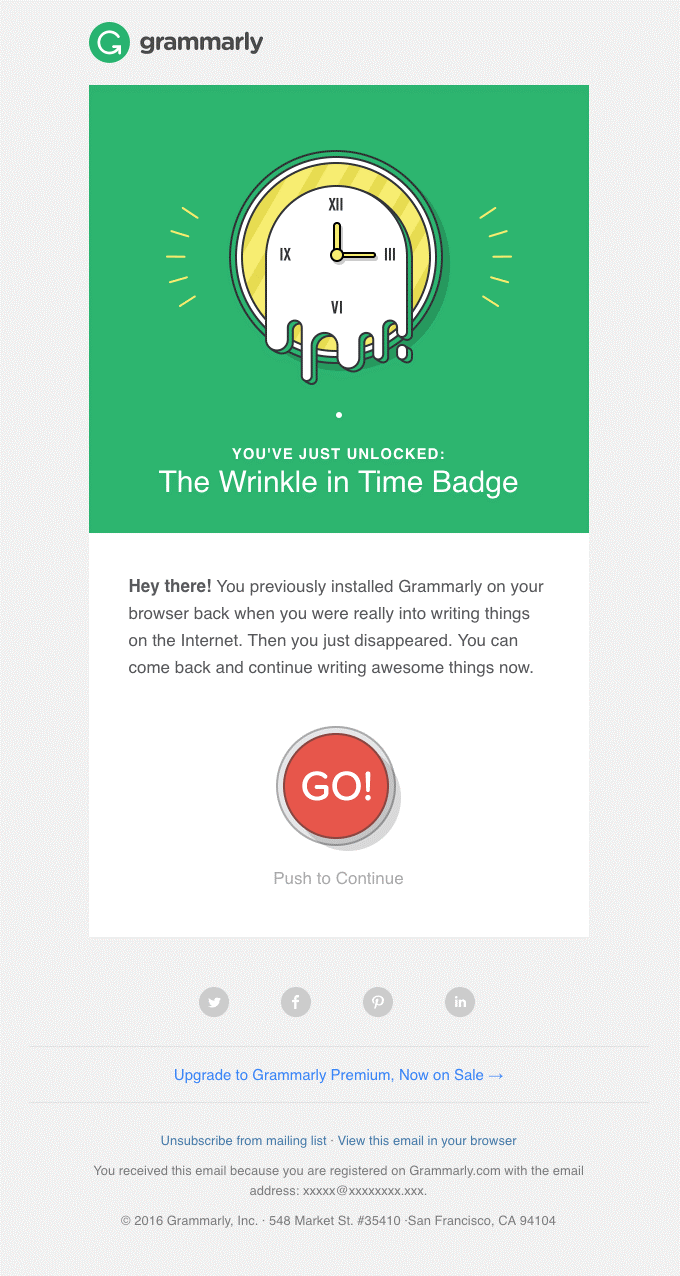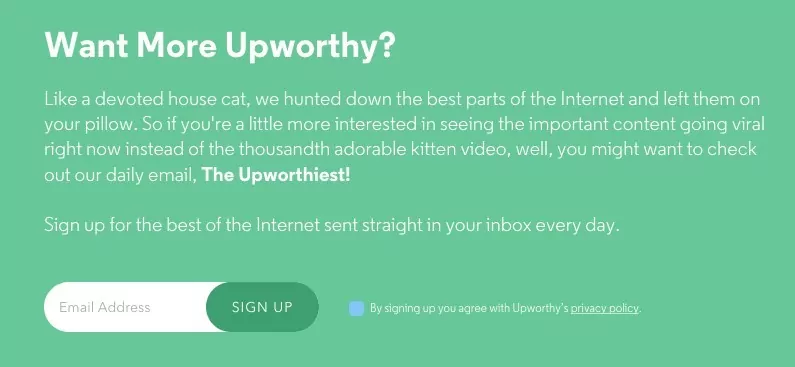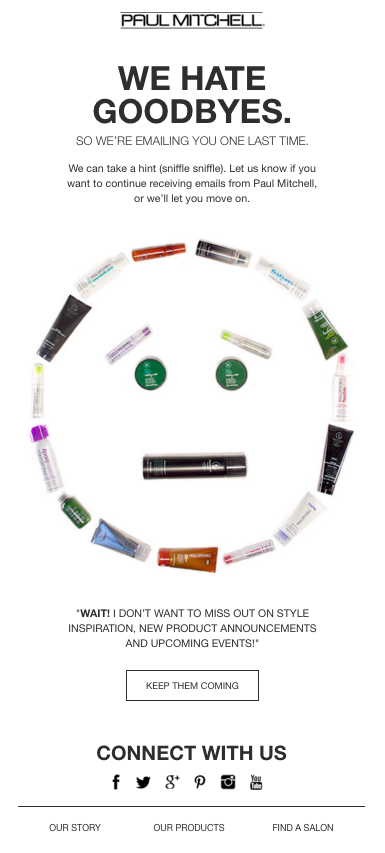Here are some email list management best practices to get you moving in the right direction.
- Send a welcome email — When someone signs up for your email list, send them a welcome email. This is something you can automate and it’s a nice way to confirm that the person is now on your email list, that they can expect to regularly hear from you, and to let them know what kind of content you send out. It’s a simple way to build trust and start your relationship with your subscribers on the right foot.
- Here are some great welcome email examples that you can copy or steal inspiration from.
- Use a Subscription Management Center — A common reason that subscribers leave email lists is because they receive more emails than they would like… or maybe they receive too few emails to keep your business top of mind. Either way, sending outside of your subscriber’s email receiving preferences is a recipe for unsubscribes, spam reports, and maybe even getting blacklisted. Which is why using a Subscription Management Center is so powerful. This allows you to let each subscriber set their own email marketing preferences, segment based on those preferences, and then send each subscriber exactly what they want. Most high-quality ESPs will allow you to create a subscription management center for your email list. That said, the option to completely “Unsubscribe” must remain prominent and straightforward, but a preference page gives unsure subscribers a chance to opt-in to only the specific kind of content they’d like to receive. Another interesting option I’ve had clients use is a “Snooze” button/function (allowing subscribers to pause their subscription for a period of time). Typically, you can expect about 3-5% of subscribers to select to pause for a period of time rather than completely unsubscribing from a list.

- Create quarterly cadence for cleaning your list — At the heart of list management is regularly scrubbing your email list. Doing this is often a tedious process, though, that can be outsourced to a piece of software or an assistant. However it’s done, you should create a consistent, recurring (quarterly should do the trick) process for cleaning your email list of email addresses which regularly hard bounce, soft bounce, or haven’t engaged for a certain period of time (6 months, for instance).
- Here is a helpful guide for cleaning your email list.
- Segment your list — The primary goal of having a list management strategy is to ensure your list consistently engages with the content you send them. And one of the best ways to ensure that people engage with your emails is to segment your list by behavior, interests, demographics, or different buyer personas. Most ESPs will allow you to segment your list with tags, and even automate certain sequences for those segmentations. This builds a healthy relationship with your subscribers and ensures that you’re sending each person the type of content that they are most interested in receiving.
- Here is a helpful guide to learn more about email list segmentation.
- Create re-engagement campaigns — It’d be easy to delete email addresses from your list without a second thought in an effort to clean up your email marketing metrics. After all, a high bounce rate could do serious harm to your IP address reputation down the road. But before you click “delete”, send a re-engagement campaign. You might be surprised just how many subscribers you keep on your list by making an effort to keep them engaged. A re-engagement campaign’s only goal is to get subscribers who haven’t engaged with your emails for quite some time (haven’t opened or clicked for 6-12 months) to… well, engage. Some near-lost subscribers just need a gentle reminder that you’re still in their inbox, delivering value.
- Here’s a great guide about creating high-performing re-engagement email campaigns.
- And here are a few examples of awesome re-engagement campaigns.

- Make it easy to unsubscribe — At the heart of a good list management strategy is healthy email marketing metrics. Really, that’s the entire purpose of consistent list management: to keep your IP address reputation sparkly white, to keep your subscribers engaged (open rate and click-through rate), and to generate conversions and revenue for your business. The ground-level beginning of that process is to let subscribers leave when they want to leave. While it might seem like a blow to the marketing side of your brain (Shouldn’t I try to convince them otherwise??), it isn’t. Every great marketing campaign requires honesty and transparency and a healthy relationship. If a subscriber wants out, you have to let them out. So put your unsubscribe button where it’s easy to see and easy to click. People who love receiving your emails won’t unsubscribe just because it’s easy to see. But people who want off your list will appreciate it and gain respect for your business, even on their way out.
- Get correct permissions — Perhaps the fastest way to destroy your email marketing reputation is to email people who didn’t give you permission to email them. This can hurt your email marketing efforts in two ways. First, your subscribers won’t like it. No one wants a stranger walking into their house unannounced, and no one wants to be added to your list without first being asked. And second, Can-Spam and GDPR regulations require you to get permission from each subscriber before sending them marketing emails. Breaking that regulation comes with repercussions: namely, a hurting IP address reputation which contributes to a higher bounce rate, more emails going to spam, and lower overall deliverability. Always get permission before sending emails to anyone. This can be done with a simple opt-in form like the one below.

- Beware of buying your list — Want 10,000 subscribers in five minutes? It’s appealing, right? Even at a 2% conversion rate, you could make 200 sales with that list. But, of course, there are a lot of problems with buying an email list. First of all, you probably won’t get much of a conversion rate since the people you’re emailing have no idea who you are and never opted into your email list of their own free will. And because they never gave you permission to email them, there’s a higher chance of those subscribers reporting your emails as spam and decreasing the deliverability rate of future emails. It’s far better to build an email list organically. But if you do decide to buy subscribers, get permission to continue sending them emails after the purchase and try to warm them up to your business before making any hard pitches. Email marketing is a relationship, and you must respect that if you’re going to be successful.
- Here’s a list of reasons why you should never buy an email list.
- Keep an updated do-not-email list — Whenever an email hard bounces, soft bounces repeatedly, or unsubscribes from your list, take note. It’s good practice to keep a running and updated list of all the contacts which you shouldn’t be contacting, outside of your ESP. That way, if you ever choose to switch ESPs, you can easily and quickly upload your do-not-mail list and keep your metrics where you want them.

